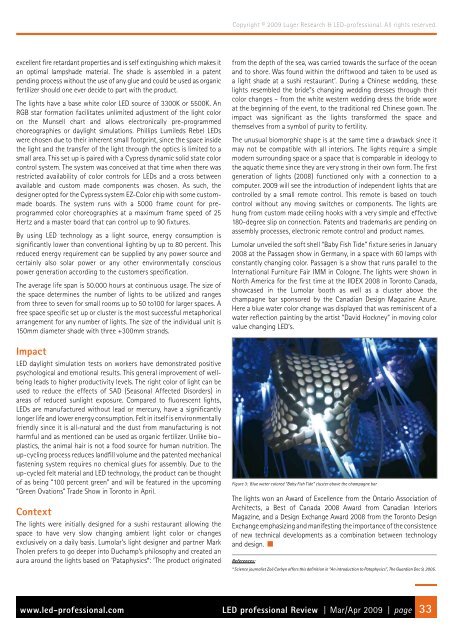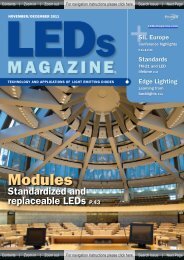LED Applications & Lighting Systems - fonarevka
LED Applications & Lighting Systems - fonarevka
LED Applications & Lighting Systems - fonarevka
Create successful ePaper yourself
Turn your PDF publications into a flip-book with our unique Google optimized e-Paper software.
Copyright © 2009 Luger Research & <strong>LED</strong>-professional. All rights reserved.<br />
excellent fire retardant properties and is self extinguishing which makes it<br />
an optimal lampshade material. The shade is assembled in a patent<br />
pending process without the use of any glue and could be used as organic<br />
fertilizer should one ever decide to part with the product.<br />
The lights have a base white color <strong>LED</strong> source of 3300K or 5500K. An<br />
RGB star formation facilitates unlimited adjustment of the light color<br />
on the Munsell chart and allows electronically pre-programmed<br />
choreographies or daylight simulations. Phillips Lumileds Rebel <strong>LED</strong>s<br />
were chosen due to their inherent small footprint, since the space inside<br />
the light and the transfer of the light through the optics is limited to a<br />
small area. This set up is paired with a Cypress dynamic solid state color<br />
control system. The system was conceived at that time when there was<br />
restricted availability of color controls for <strong>LED</strong>s and a cross between<br />
available and custom made components was chosen. As such, the<br />
designer opted for the Cypress system EZ-Color chip with some custommade<br />
boards. The system runs with a 5000 frame count for preprogrammed<br />
color choreographies at a maximum frame speed of 25<br />
Hertz and a master board that can control up to 90 fixtures.<br />
By using <strong>LED</strong> technology as a light source, energy consumption is<br />
significantly lower than conventional lighting by up to 80 percent. This<br />
reduced energy requirement can be supplied by any power source and<br />
certainly also solar power or any other environmentally conscious<br />
power generation according to the customers specification.<br />
The average life span is 50.000 hours at continuous usage. The size of<br />
the space determines the number of lights to be utilized and ranges<br />
from three to seven for small rooms up to 50 to100 for larger spaces. A<br />
free space specific set up or cluster is the most successful metaphorical<br />
arrangement for any number of lights. The size of the individual unit is<br />
150mm diameter shade with three +300mm strands.<br />
Impact<br />
<strong>LED</strong> daylight simulation tests on workers have demonstrated positive<br />
psychological and emotional results. This general improvement of wellbeing<br />
leads to higher productivity levels. The right color of light can be<br />
used to reduce the effects of SAD (Seasonal Affected Disorders) in<br />
areas of reduced sunlight exposure. Compared to fluorescent lights,<br />
<strong>LED</strong>s are manufactured without lead or mercury, have a significantly<br />
longer life and lower energy consumption. Felt in itself is environmentally<br />
friendly since it is all-natural and the dust from manufacturing is not<br />
harmful and as mentioned can be used as organic fertilizer. Unlike bio–<br />
plastics, the animal hair is not a food source for human nutrition. The<br />
up-cycling process reduces landfill volume and the patented mechanical<br />
fastening system requires no chemical glues for assembly. Due to the<br />
up-cycled felt material and <strong>LED</strong> technology, the product can be thought<br />
of as being “100 percent green” and will be featured in the upcoming<br />
“Green Ovations” Trade Show in Toronto in April.<br />
Context<br />
The lights were initially designed for a sushi restaurant allowing the<br />
space to have very slow changing ambient light color or changes<br />
exclusively on a daily basis. Lumolar’s light designer and partner Mark<br />
Tholen prefers to go deeper into Duchamp’s philosophy and created an<br />
aura around the lights based on ‘Pataphysics*: ‘The product originated<br />
from the depth of the sea, was carried towards the surface of the ocean<br />
and to shore. Was found within the driftwood and taken to be used as<br />
a light shade at a sushi restaurant’. During a Chinese wedding, these<br />
lights resembled the bride”s changing wedding dresses through their<br />
color changes – from the white western wedding dress the bride wore<br />
at the beginning of the event, to the traditional red Chinese gown. The<br />
impact was significant as the lights transformed the space and<br />
themselves from a symbol of purity to fertility.<br />
The unusual biomorphic shape is at the same time a drawback since it<br />
may not be compatible with all interiors. The lights require a simple<br />
modern surrounding space or a space that is comparable in ideology to<br />
the aquatic theme since they are very strong in their own form. The first<br />
generation of lights (2008) functioned only with a connection to a<br />
computer. 2009 will see the introduction of independent lights that are<br />
controlled by a small remote control. This remote is based on touch<br />
control without any moving switches or components. The lights are<br />
hung from custom made ceiling hooks with a very simple and effective<br />
180-degree slip on connection. Patents and trademarks are pending on<br />
assembly processes, electronic remote control and product names.<br />
Lumolar unveiled the soft shell “Baby Fish Tide” fixture series in January<br />
2008 at the Passagen show in Germany, in a space with 60 lamps with<br />
constantly changing color. Passagen is a show that runs parallel to the<br />
International Furniture Fair IMM in Cologne. The lights were shown in<br />
North America for the first time at the IIDEX 2008 in Toronto Canada,<br />
showcased in the Lumolar booth as well as a cluster above the<br />
champagne bar sponsored by the Canadian Design Magazine Azure.<br />
Here a blue water color change was displayed that was reminiscent of a<br />
water reflection painting by the artist “David Hockney” in moving color<br />
value changing <strong>LED</strong>’s.<br />
Figure 3: Blue water colored “Baby Fish Tide” cluster above the champagne bar<br />
The lights won an Award of Excellence from the Ontario Association of<br />
Architects, a Best of Canada 2008 Award from Canadian Interiors<br />
Magazine, and a Design Exchange Award 2008 from the Toronto Design<br />
Exchange emphasizing and manifesting the importance of the consistence<br />
of new technical developments as a combination between technology<br />
and design.<br />
References:<br />
* Science journalist Zoë Corbyn offers this definition in “An introduction to Pataphysics”, The Guardian Dec 9, 2005.<br />
www.led-professional.com <strong>LED</strong> professional Review | Mar/Apr 2009 | page 33

















